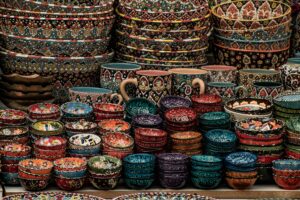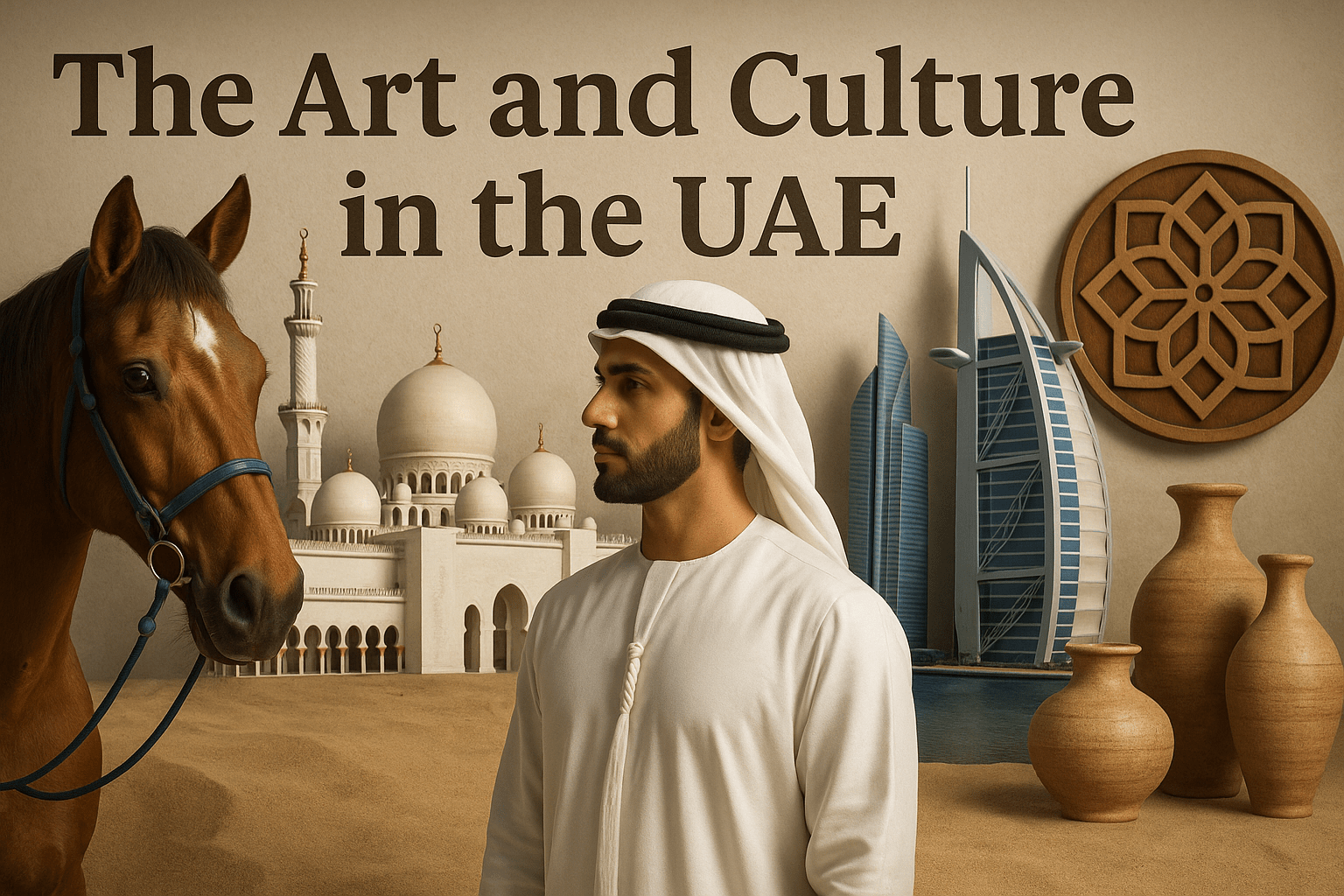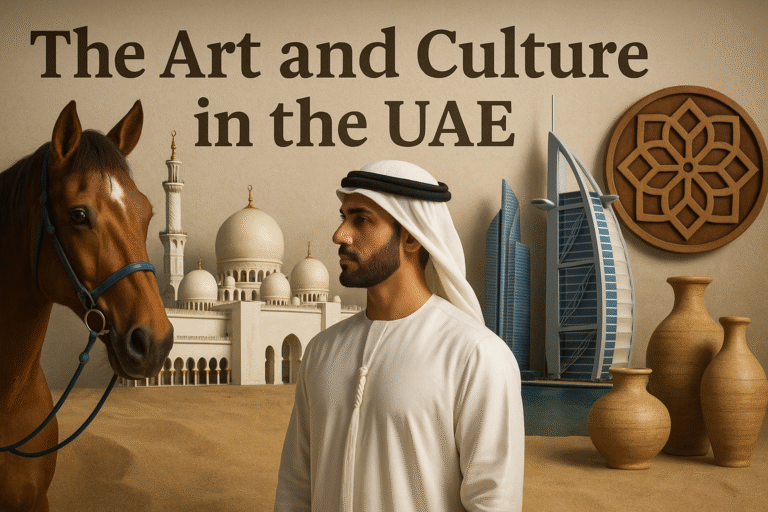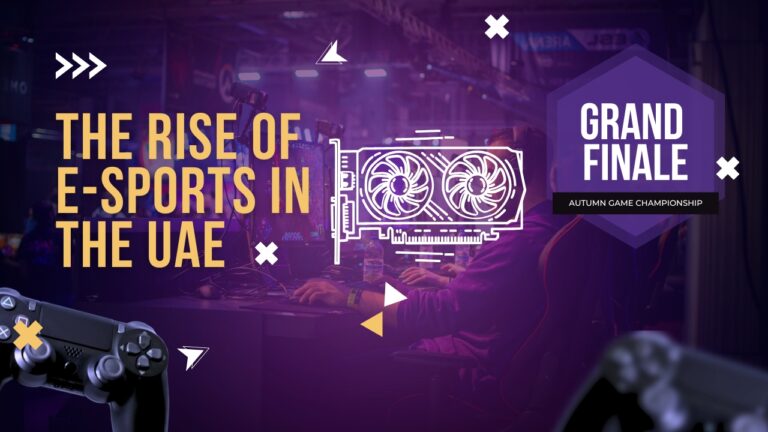The United Arab Emirates, often perceived through the lens of its soaring skylines and economic prowess, holds a deeply rich and evolving tapestry of art and culture. Far from being a recent phenomenon, the UAE’s cultural identity is rooted in centuries of Bedouin traditions, Islamic heritage, and a profound connection to the sea and desert. Today, this heritage blends seamlessly with a vibrant contemporary art scene, international cultural institutions, and a global outlook, creating a unique and compelling narrative. Understanding this cultural depth is key to appreciating the UAE beyond its modern facade.
For centuries, the Emirati people lived in harmony with their natural environment, developing a culture characterized by resilience, hospitality, and a strong sense of community. Oral traditions, poetry (especially Nabati poetry), folk music, dance (such as the Al Ayyala), and intricate handicrafts were central to daily life. Falconry, camel racing, and pearl diving were not just livelihoods but deeply embedded cultural practices passed down through generations. These foundational elements continue to shape the Emirati identity and are celebrated with immense pride, forming the bedrock of the nation’s cultural expression.
The arrival of Islam in the 7th century profoundly influenced the region, shaping its architecture, calligraphy, storytelling, and ethical values. Mosques, with their intricate geometric patterns and soaring minarets, stand as testaments to this enduring legacy. Arabic calligraphy, a revered art form, adorns public spaces and private homes, transforming written words into visual masterpieces. Islamic principles of hospitality, generosity, and respect for elders remain central to Emirati society, offering a warm embrace to visitors and residents alike.

The discovery of oil in the mid-20th century marked a pivotal moment, ushering in an era of unprecedented development and urbanization. While this rapid modernization brought about significant societal changes, the leadership of the UAE has been remarkably committed to preserving and promoting its cultural heritage. This foresight has ensured that traditional arts and customs are not lost but instead integrated into the nation’s contemporary identity, bridging the past and the present with remarkable grace.
In recent decades, the UAE has emerged as a major player on the global art and culture stage, actively investing in museums, art districts, and cultural initiatives. This strategic vision aims to foster creativity, encourage dialogue, and position the country as a hub for artistic expression and intellectual exchange. The transformation is particularly visible in cities like Abu Dhabi and Dubai, which have become magnets for international art lovers and cultural connoisseurs.
Abu Dhabi, the capital, is home to a cluster of world-class cultural institutions on Saadiyat Island, often referred to as the Saadiyat Cultural District. The Louvre Abu Dhabi, with its iconic dome of light, is a universal museum that transcends civilizations, showcasing art and artifacts from around the world. Its thoughtful curation tells stories of shared human experiences, fostering cross-cultural understanding. This groundbreaking museum represents a significant commitment to global cultural dialogue.
Adjacent to the Louvre Abu Dhabi, the Guggenheim Abu Dhabi is currently under construction, designed by the acclaimed architect Frank Gehry. This contemporary art museum will further elevate Abu Dhabi’s status as a global art destination, focusing on modern and contemporary art from the 1960s to the present. Its presence signals a bold vision for showcasing diverse artistic perspectives.
Also planned for Saadiyat Island is the Zayed National Museum, designed by Lord Norman Foster. This museum will be a national institution dedicated to the life and achievements of the UAE’s founding father, Sheikh Zayed bin Sultan Al Nahyan, and the history and culture of the UAE. It will serve as a vital repository of Emirati heritage, educating future generations and visitors alike.
Beyond these grand institutions, Abu Dhabi hosts numerous art galleries, cultural centers, and annual events like the Abu Dhabi Art fair, which attracts leading galleries, artists, and collectors from around the globe. These initiatives provide platforms for both established and emerging artists, fostering a vibrant local art scene and encouraging artistic experimentation.

Dubai, a city known for its dynamism, has also cultivated a flourishing art and culture landscape. Alserkal Avenue in Al Quoz is a prime example of this evolution. Once an industrial zone, it has been transformed into a bustling arts and culture district, home to contemporary art galleries, creative studios, concept stores, pop-up events, and unique eateries. It’s a place where local and international artists showcase their work, workshops are held, and cultural conversations flourish, embodying a grassroots artistic spirit.
The Dubai Design District (d3) is another significant hub, dedicated to fashion, design, and art. It provides a creative ecosystem for designers, artists, and innovators, hosting events like Dubai Design Week and Sole DXB, which attract a global audience. d3’s commitment to nurturing creative talent makes it a cornerstone of Dubai’s artistic identity, fostering collaboration and innovation across various creative disciplines.
Traditional arts and heritage are meticulously preserved and celebrated across the UAE. The Al Fahidi Historical Neighbourhood (formerly Al Bastakiya) in Dubai offers a captivating glimpse into the city’s past, with its narrow sikkas (alleys), wind-tower architecture, and charming courtyards. Here, visitors can explore art galleries, museums like the Dubai Museum (housed in the Al Fahidi Fort), and cultural centers that showcase Emirati customs, craftsmanship, and way of life. The Sheikh Mohammed Centre for Cultural Understanding (SMCCU) in this neighborhood offers unique cultural experiences, including traditional Emirati meals and interactive sessions on local customs, fostering a deeper understanding of Emirati heritage.
The Sharjah Art Foundation stands as a testament to Sharjah’s long-standing commitment to the arts. Known for its visionary contemporary art programming, it hosts the internationally acclaimed Sharjah Biennial, which attracts artists and curators from around the world. Sharjah also boasts a remarkable array of museums, including the Sharjah Art Museum, Sharjah Museum of Islamic Civilization, and the Sharjah Calligraphy Museum, solidifying its reputation as the cultural capital of the Arab world. Its dedication to preserving heritage while embracing modernity makes it a unique cultural destination within the UAE.
Festivals and events play a crucial role in showcasing the UAE’s diverse cultural offerings. The Dubai Shopping Festival and Dubai Summer Surprises often integrate cultural performances, traditional markets (souks), and art installations. More focused events like the Emirates Airline Festival of Literature bring together authors and literary enthusiasts from around the globe, fostering a love for reading and storytelling. Film festivals, music concerts featuring international and regional artists, and theatrical productions further enrich the cultural calendar, offering something for every artistic palate.
The UAE’s commitment to arts education is also growing, with universities and institutions offering programs in fine arts, design, music, and performing arts. This investment in talent development ensures a continuous pipeline of creative individuals who will contribute to the nation’s evolving cultural landscape. Initiatives to support local artists through grants, residencies, and exhibition opportunities are empowering a new generation of Emirati creatives to express themselves and share their perspectives with the world.
Looking ahead, the UAE continues to invest in innovative cultural projects that push boundaries and encourage cross-cultural dialogue. The drive towards digital transformation is also influencing the cultural sphere, with virtual exhibitions, online performances, and digital art becoming increasingly prevalent, making art and culture more accessible to a wider audience. This fusion of tradition and technology ensures that the UAE’s cultural narrative remains dynamic and globally relevant.
The art and culture of the UAE are far more than just a backdrop; they are a living, breathing testament to the nation’s identity, its respect for heritage, and its ambition for the future. From the ancient echoes of Bedouin poetry to the avant-garde expressions in contemporary galleries, the UAE offers a multifaceted cultural experience. It is a place where traditions are cherished, creativity is nurtured, and global cultures converge, making it a truly unique and compelling destination for anyone seeking to explore the depths of human artistry and heritage. The journey through the UAE’s art and culture scene is one of discovery, offering insights into a nation that beautifully balances its rich past with a vibrant, forward-looking present.
We Are UAE’s Top Company Formation Companies In Dubai.
Visit for more information www.kinjalpatel.ae Or +971543420376
Expert In Business Formation In Dubai. (Whatsapp)
FAQ’s:
How To Setup Business In Uae?
How To Do Company Registration In Dubai?
How To Start A Business In Dubai ?
How To Find Best Company Formation Companies In Dubai?
Whats The Process For Business Setup In Dubai?
Benefits Of Business Setup In Dubai?
Find all answers;
www.kinjalpatel.ae
(Linkedin)






+ There are no comments
Add yours